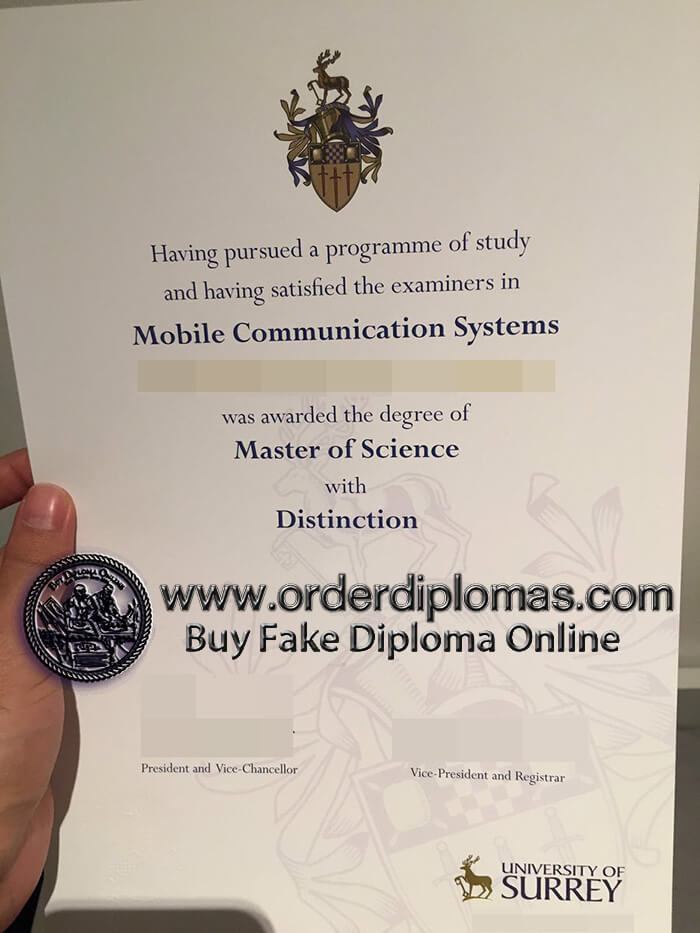
buy fake University of Surrey degree
Buy fake University of Surrey diploma, buy fake University of Surrey degree, buy fake University of Surrey certificate, buy fake University of Surrey diploma online, make fake University of Surrey diploma, order fake diploma, buy fake diploma, buy fake degree.
The University of Surrey is a public research university in Guildford, Surrey, England. The university received its royal charter in 1966, along with a number of other institutions following recommendations in the Robbins Report. The institution was previously known as Battersea College of Technology and was located in Battersea Park, London. Its roots however, go back to Battersea Polytechnic Institute, founded in 1891 to provide further and higher education in London, including its poorer inhabitants. The university’s research output and global partnerships have led to it being regarded as one of the UK’s leading research universities.
The university is a member of the Association of MBAs and is one of four universities in the University Global Partnership Network. It is also part of the SETsquared partnership along with the University of Bath, the University of Bristol, the University of Southampton and the University of Exeter. The university’s main campus is on Stag Hill, close to the centre of Guildford and adjacent to Guildford Cathedral. Surrey Sports Park is situated at the nearby Manor Park, the university’s secondary campus. Among British universities, the University of Surrey had the 14th highest average UCAS Tariff for new entrants in 2015.
A major centre for satellite and mobile communications research, the university is in partnership with King’s College London and the Dresden University of Technology to develop 5G technology worldwide. It also holds a number of formal links with institutions worldwide, including the Surrey International Institute, launched in partnership with the Dongbei University of Finance and Economics. The university owns the Surrey Research Park, providing facilities for over 110 companies engaged in research. Surrey has been awarded three Queen’s Anniversary Prizes for its research, with the 2021 Research Excellence Framework seeing the university rise 12 places to 33rd in the UK for overall research quality and 41% of the university’s research outputs classified as “world leading”. It was named as The Sunday Times University of the Year in 2016, was nominated again for the same accolade in 2023, and was The Sunday Times University of the Year for Graduate Employment in 2022.
The chancellor of the university is Prince Edward, Duke of Kent. Current and emeritus academics at the university include ten Fellows of the Royal Society, twenty-one Fellows of the Royal Academy of Engineering, one Fellow of the British Academy and six Fellows of the Academy of Social Sciences. Surrey has educated many notable alumni, including Olympic gold medallists, several senior politicians, as well as a number of notable persons in various fields including the arts, sports and academia. Graduates typically abbreviate the University of Surrey to Sur when using post-nominal letters after their degree.
Foundation and early period
The university’s original Battersea campus, including its Great Hall
The University of Surrey was preceded by the Battersea Polytechnic Institute which was founded in 1891 and admitted its first students in 1894. Its aim was to provide greater access to further and higher education for Londoners, including some of the city’s “poorer inhabitants”. In 1901, evening classes provided instruction in subjects such as Mechanical Engineering and Building, Electrical Engineering, Chemical and other trades, Physics and Natural Science, Maths, Languages, Commercial subjects, Music and special classes for women including Domestic Economy subjects. Day classes consisted of Art, Science, Women’s Subjects and Gymnastics, and classes were also offered in preparation for university and professional examinations. The institute focused on science and technology subjects, and from about 1920 taught University of London students, awarding University of London external degrees.
In 1956, the institute was among the first to receive the designation “College of Advanced Technology” and was renamed Battersea College of Technology. By the beginning of the sixties, the college had virtually outgrown its building in Battersea and had decided to move to Guildford. In addition to this, the Robbins Report of 1963 proposed that the Colleges of Advanced Technology, including Battersea, should expand and become degree-awarding universities. In 1965, the university-designate acquired a greenfield site in Guildford from Guildford Cathedral, Guildford Borough Council and the Onslow Village Trust.

 USA Diplomas
USA Diplomas Canada Diplomas
Canada Diplomas UK Diplomas
UK Diplomas Australia Diplomas
Australia Diplomas Germany Diplomas
Germany Diplomas Malaysia Diplomas
Malaysia Diplomas Singapore Diplomas
Singapore Diplomas Other countries
Other countries Transcript-Form.xlsx
Transcript-Form.xlsx
